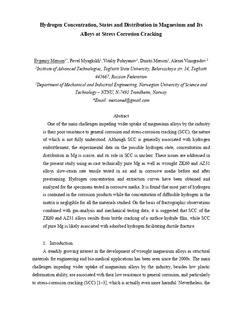| dc.contributor.author | Merson, Evgeni | |
| dc.contributor.author | Myagkikh, Pavel | |
| dc.contributor.author | Poluyanov, Vitaliy | |
| dc.contributor.author | Merson, Dmitri | |
| dc.contributor.author | Vinogradov, Alexey | |
| dc.date.accessioned | 2020-01-31T13:54:32Z | |
| dc.date.available | 2020-01-31T13:54:32Z | |
| dc.date.created | 2019-05-30T14:46:04Z | |
| dc.date.issued | 2019 | |
| dc.identifier.citation | Materials Science & Engineering: A. 2019, 748 337-346. | nb_NO |
| dc.identifier.issn | 0921-5093 | |
| dc.identifier.uri | http://hdl.handle.net/11250/2639105 | |
| dc.description.abstract | One of the main challenges impeding wider uptake of magnesium alloys by the industry is their poor resistance to general corrosion and stress-corrosion cracking (SCC), the nature of which is not fully understood. Although SCC is generally associated with hydrogen embrittlement, the experimental data on the possible hydrogen state, concentration and distribution in Mg is scarce, and its role in SCC is unclear. These issues are addressed in the present study using as-cast technically pure Mg as well as wrought ZK60 and AZ31 alloys slow-strain rate tensile tested in air and in corrosive media before and after prestraining. Hydrogen concentration and extraction curves have been obtained and analyzed for the specimens tested in corrosive media. It is found that most part of hydrogen is contained in the corrosion products while the concentration of diffusible hydrogen in the matrix is negligible for all the materials studied. On the basis of fractographic observations combined with gas-analysis and mechanical testing data, it is suggested that SCC of the ZK60 and AZ31 alloys results from brittle cracking of a surface hydride film, while SCC of pure Mg is likely associated with adsorbed hydrogen facilitating ductile fracture. | nb_NO |
| dc.language.iso | eng | nb_NO |
| dc.publisher | Elsevier | nb_NO |
| dc.rights | Attribution-NonCommercial-NoDerivatives 4.0 Internasjonal | * |
| dc.rights.uri | http://creativecommons.org/licenses/by-nc-nd/4.0/deed.no | * |
| dc.title | On the role of hydrogen in stress corrosion cracking of magnesium and its alloys: Gas-analysis study | nb_NO |
| dc.type | Journal article | nb_NO |
| dc.type | Peer reviewed | nb_NO |
| dc.description.version | acceptedVersion | nb_NO |
| dc.source.pagenumber | 337-346 | nb_NO |
| dc.source.volume | 748 | nb_NO |
| dc.source.journal | Materials Science & Engineering: A | nb_NO |
| dc.identifier.doi | 10.1016/j.msea.2019.01.107 | |
| dc.identifier.cristin | 1701601 | |
| dc.description.localcode | © 2019. This is the authors’ accepted and refereed manuscript to the article. Locked until 31.1.2021 due to copyright restrictions. This manuscript version is made available under the CC-BY-NC-ND 4.0 license http://creativecommons.org/licenses/by-nc-nd/4.0/ | nb_NO |
| cristin.unitcode | 194,64,92,0 | |
| cristin.unitname | Institutt for maskinteknikk og produksjon | |
| cristin.ispublished | true | |
| cristin.fulltext | postprint | |
| cristin.qualitycode | 2 | |

